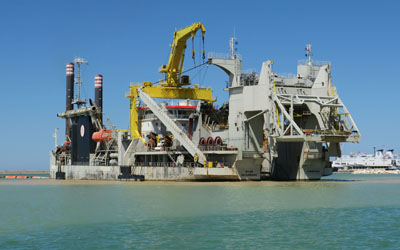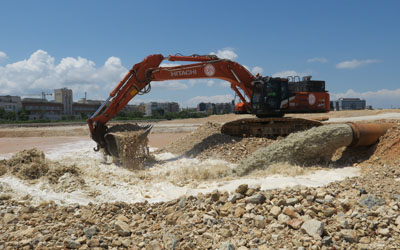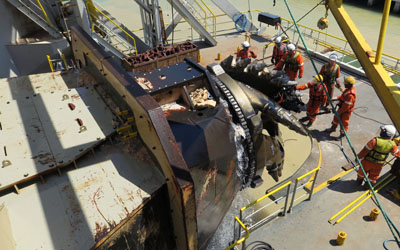
The Willem Van Rubroeck dredging in the port of Bari
With a total installed power of 41,346 kW it is one of the most powerful dredgers in the world.
After having completed its first assignment in the African country Mauritania, the new dredger was sent back to Europe to be deployed on a challenging project in the port of Bari in Southern Italy.
Bari is the capital of the Italian region Puglia and is a important economic centre of southern Italy, it is also a famous tourist attraction, mainly because of its old town Bari Vecchia.
To relieve the pressure on the existing port facilities as well as make the area between the port and Bari Vecchia more attractive from a tourist point of view, the Italian government, that owns the port, has a long-cherished wish to transfer a large part of the commercial port activities westward to a new area and away from the old city.
Analysis had shown that the limestone to be dredged had a compressive strength of 30 MPa and above, in some cases it even reached 70 MPa, comparable to the strongest concrete types.
By the end of July 2022, Jan De Nul's project team could look back on a very successful dredging operation.
Located on the Adriatic coast, its port constitutes a main link with many Balkan countries.
There are several ferry and roll-on-off (RoRo) routes to and from Croatia, Montenegro, Albania and Greece, each of them being served on a daily basis.
But, the port also has regular calls of cruise ships and handles a variety of cargo vessels.
At present, all commercial port activities are concentrated in an area adjacent to the old city (Bari Vecchia), which is highly frequented by both Italian as well as international tourists.
However, insufficient budget and difficult circumstances for dredging have long blocked the realisation of this plan.
In fact, dredging would be needed of very hard and resistant limestone.
Two types of limestone are very common in the Puglia region, the well known Calcare di Bari and Calcarenite di Gravina.
Up until about two decades ago, the excavation of this type of material would require drilling an blasting, a costly operation that is also not accepted at this location due to the proximity of many buildings and infrastructure.
It was with the recent development and up-scaling of the cutter suction type dredger, with a total installed power of 23,000 kW and above, that the realisation of the port's plans came into reach.
Once enough funds became available, the Italian Ministry of sustainable Infrastructures and Mobility (Ministero delle Infrastrutture e della Mobilità sostenibili) was able to make serious preparations for the realisation of this project.

The reclamation at Marisabella
In 2012, the Ministry's interregional agency (Provveditorato Interregionale) for the regions Campania, Puglia, Molise e Basilicata awarded a contract to an Italian joint venture with Fincosit srl as leading partner.
This contract covered the dredging of limestone near the existing Pizzoli pier to a depth of 12 meters, representing approx. 600,000 m3 of material and the reclamation of the area known as Marisabella that is to serve as future handling area for goods, trucks and cars.
Furthermore new quay walls are to be constructed, score protection has to be installed and the Marisabella reclamation has to be profiled and paved.
The dredging works were later subcontracted by the joint venture to Jan De Nul Group.
As mentioned, the later has deployed the CSD Willem Van Rubroeck for this difficult and challenging task.
Another parameter that indicates how difficult rock type material is to dredge is the RQD.
RQD stands for Rock Quality Designation, it is expressed in percentage and indicates the degree of fracture of the rock.
The higher the percentage, the more solid and massive the rock is, the low it is, the more it has been subject to wear and the more it is fractured.
Obviously, this also means that the higher the RQD, the more difficult it is to break and dredge.

Cutter check on the Willem Van Rubroeck
In Bari, approx. a tenth of the material to be excavated by the Willem Van Rubroeck had a RQD of between 70% and 90% and some 2% of the material even had a RQD of 100%, which means it is downright massive.
To deal with this kind of material, the Willem Van Rubroeck had two types of ESCO heavy-duty cutter systems at its disposal.
The first one is the 68D type, which until recently was ESCO's largest cutterhead, this type has been designed for heavy-duty rock excavation by large CSDs.
But recently, ESCO has developed a new type of cutterhead that is specifically meant to be used on the latest generation of ultra-large CSDs with a total installed power of over 40,000 kW.
This new cutter system is known as ESCO 9G, besides a redesigned cutterhead, it has also newly developed extremely resistant heavy-weight adapters and pick points, with an individual weight of 51 kg.
With these cutter systems and its enormous cutter power of 8,500 kW, the Willem Van Rubroeck, despite the challenging circumstances, succeeded in getting all the 600,000 m3 of material out and pump it into the Marisabella reclamation in just two months of time.
The Willem Van Rubroeck will now be prepared for a next assignment and in the meantime, the staff of main contractor Fincosit can concentrate on the remaining work to be carried out on the Bari port project.